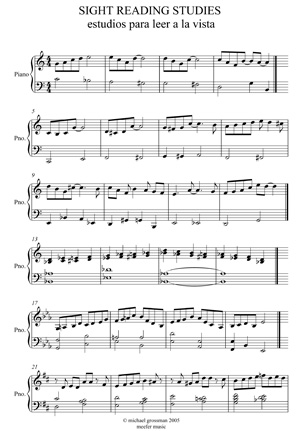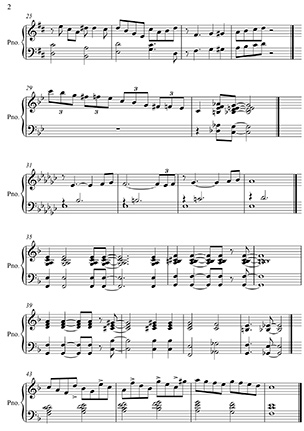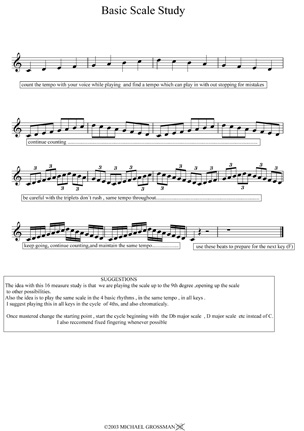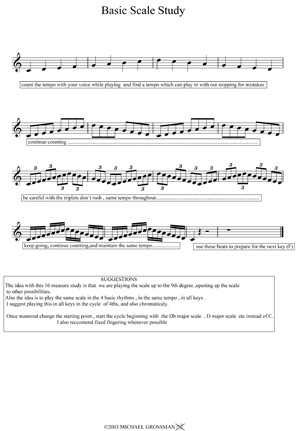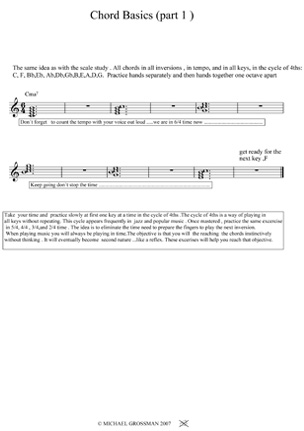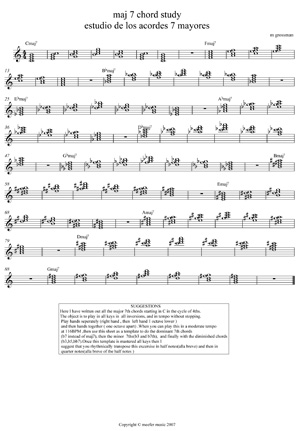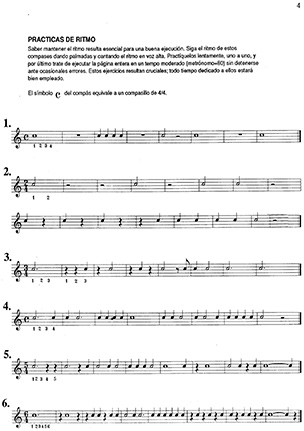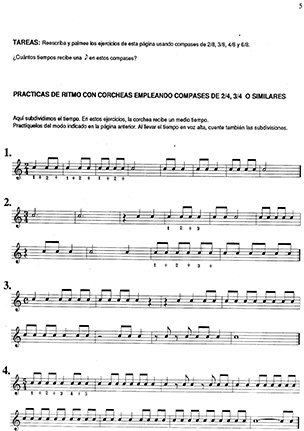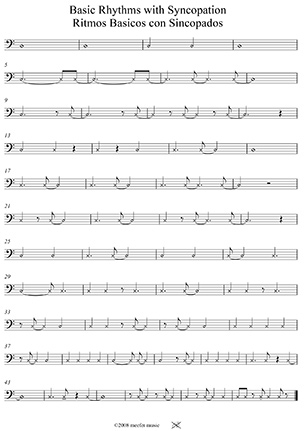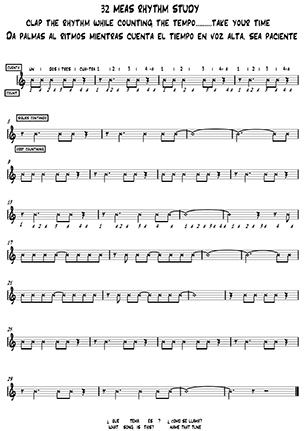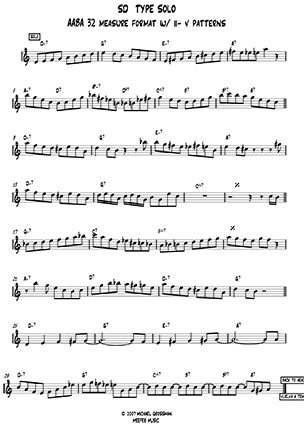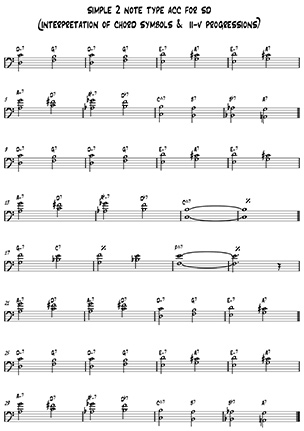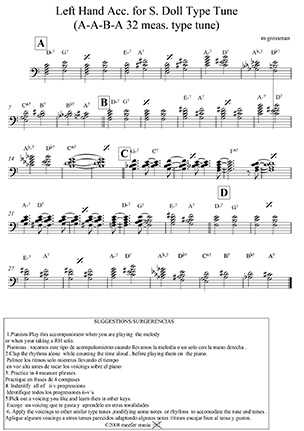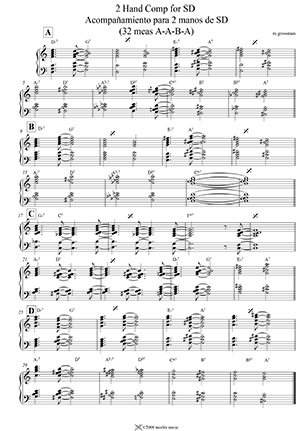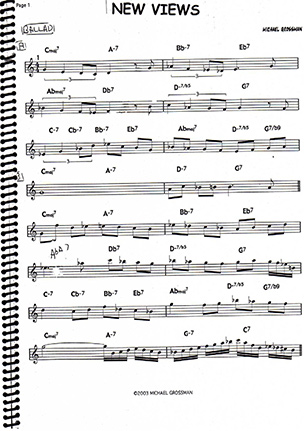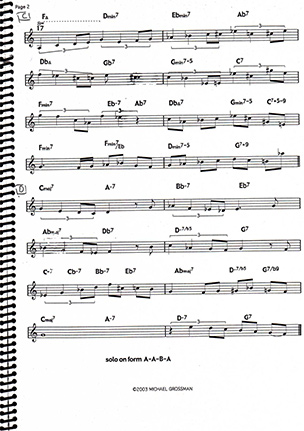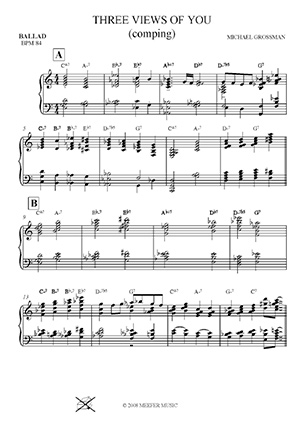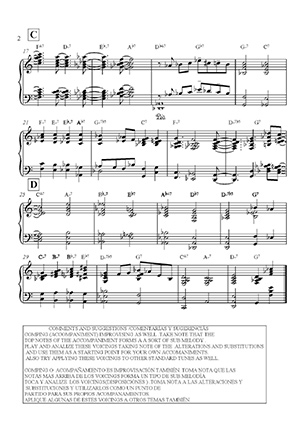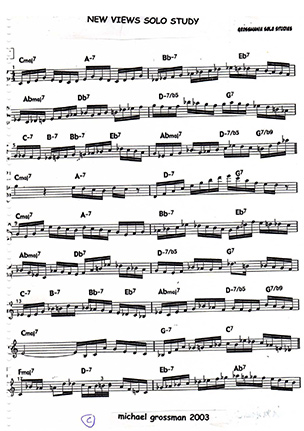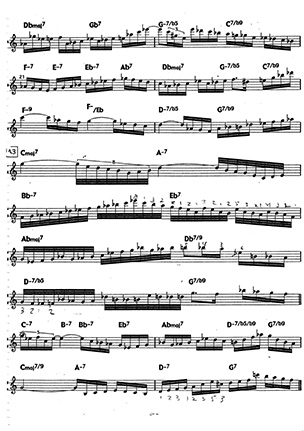Welcome to the Workshop. In the early 60´s Dennis Sandole gave a series of music workshops in New York . Ironically, when I moved to Barcelona in 1992, I taught at a school called The Musicians´s Workshop(Taller de Musics) where I adapted and developed my concepts to the needs of my students. What you´ll view here are the results of my time spent there, as well as some of the seminars I’ve presented at conservatories for classical musicians who want to learn jazz. The material may not look like much but it is concentrated and if applied will develop your technique, knowledge and ears for playing jazz and popular music. The material is meant to be played . I will be be adding more studies from time to time so keep checking back.
Bienvenidos al Taller .En los principios de los años 60´s, Dennis Sandole dio una serie de talleres para músicos en New York . Irónicamente, cuando vine a Barcelona en 1992, trabajé en una escuela que se llama El Taller de Musics donde yo adapté y desarrollé mis conceptos a las necesidades de mis estudiantes. Aquí están los resultados de mi estancia allí, así como algunos de los seminarios que yo he presentado en los conservatorios para músicos clásicos que quieren aprender el jazz. El material no se parece mucho pero es concentrado y cuando esta aplicado, desarrollará su técnica, conocimientos y oído por tocar jazz y la música moderna. El material es para tocar. Voy a añadir más estudios de vez en cuando y le invito a volver a verlos.
On Music Teachers, How to Choose One
My suggestions and points to consider for choosing a teacher:
word of mouth: ask other musicians who they would reccomend. Ask musicians whose style you like if they teach, you could also check out music schools, ads on the internet , music magazines etc,
Call for an interview ,especially if your responding to an ad , and share your objectives with your prospective teacher ,
- Do they have a method that you believe could help you dreach your objectives?
- Be sure to share how much time you would like to dedicate towards piano/music studies?
Does this method seem reasonable? I would beware of instant, intensive , and possible abusive piano courses under the guise of learn to play piano in 7days, ,master classes, as well as courses heavy on technique and theory. Remember the objective of choosing a teacher is to help you play music!
Have you heard your prospective teacher play either in person or through recordings? Would you like to sound like them ? Do they practice what they preach?
What is the availibility/commitment level of your teacher? Are they out of town a lot? Are they dedicated teachers? Try to avoid teachers who cancel or unavailable often . Consistancy is the key.
Something about the teachers I studied with
Although I play piano most of my teachers were guitarists . From them I learned musical concepts which when once grasped could be applied to a wide variety of styles and songs leading to a quite interesting and unique repetoire .
My teachers where accomplished players whose playing I admired , they encouraged me not only to study but to work in bands, and to listen to all sorts of records and musical styles, which I did .
When I received a lesson, I learned it and eventually understood it by playing and mastering it ,in all keys. I almost never received a theoretical explanation. Above all they were patient with me .
On Music Teachers, How to Choose One
My suggestions and points to consider for choosing a teacher:
word of mouth: ask other musicians who they would reccomend. Ask musicians whose style you like if they teach, you could also check out music schools, ads on the internet , music magazines etc,
Call for an interview ,especially if your responding to an ad , and share your objectives with your prospective teacher ,
- Do they have a method that you believe could help you dreach your objectives?
- Be sure to share how much time you would like to dedicate towards piano/music studies?
Does this method seem reasonable? I would beware of instant, intensive , and possible abusive piano courses under the guise of learn to play piano in 7days, ,master classes, as well as courses heavy on technique and theory. Remember the objective of choosing a teacher is to help you play music!
Have you heard your prospective teacher play either in person or through recordings? Would you like to sound like them ? Do they practice what they preach?
What is the availibility/commitment level of your teacher? Are they out of town a lot? Are they dedicated teachers? Try to avoid teachers who cancel or unavailable often . Consistancy is the key.
Something about the teachers I studied with
Although I play piano most of my teachers were guitarists . From them I learned musical concepts which when once grasped could be applied to a wide variety of styles and songs leading to a quite interesting and unique repetoire .
My teachers where accomplished players whose playing I admired , they encouraged me not only to study but to work in bands, and to listen to all sorts of records and musical styles, which I did .
When I received a lesson, I learned it and eventually understood it by playing and mastering it ,in all keys. I almost never received a theoretical explanation. Above all they were patient with me .
Some Study Suggestions
The musical examples here are to be played and in general can be applied to all instruments with some adaptation.
Some study suggestions :
1.Above all make it sound like music, even when playing scales or arpegios.
2.Play slowly and count in time aloud or with a metronome , in phrases of or 4 or 8 measures .
3.Find a tempo where you can play the phrase without stopping . You can always find a comfortable tempo no matter slow.
4.Play the rhythms first by tapping or clapping them with your hands , while counting the time with your voice .Once you get the rhythm add the notes by playing them on your instrument .
5.If a passage gives you difficulty try different fingerings .
6.If you see a phrase you like , or find challenging , learn it in several or in all keys.
7.Increase tempo in increments
8.Try to apply the phrase or progression in other songs , adapting notes and rhythms to fit the key , tonality , and the mood of the song. Once again make it sound like music. Get the idea?
Algunas sugerencias para estudiar:
Los ejemplos musicales aquí serán tocados y se puede adaptar a todos los instrumentos. Aquí presento algunas sugerencias sobre como estudiar.
1.Primero, haz que suene como música, incluso cuando toques escalas o arpegios.
2.Toca despacio y cuente e tiempo en voz alto o con un metrónomo, en frases de o 4 o 8 compases.
3.Encuentra un tiempo dónde se puede tocar a la frase sin parar. Siempre se puede encontrar un tempo cómodo no importa si sea lento.
4.Toca los ritmos primero con palmas, mientras esta contando el tiempo en voz alto. Cuando estés cómodo con el ritmo, puedes añadir las notas sobre tocándolas sobre su instrumento.
5.Si resulta difícil tocar, prueba con otra digitación.
6.Si encuentras una frase que te gusta, apréndalo en todas las tonalidades en el ciclo de cuartos.
7.Cuando esta perfeccionada, aumenta el tiempo poquito poco.
8.Aplique la frase o progresión en otros temas, adaptando las notas y/o ritmos para encajar la armadura, tonalidad, y el humor de la canción. Una vez más, haz que suene como música, entiendes?
PAPELES TÍPICOS DE LOS INTRUMENTOS EN UN GRUPO
por Michael Grossman
Aqui es un pequeño introducción para estudiantes interesados en tocando en grupo
Here is a little primer about the basic roles of the different instruments in a group that I wrote for students interested in combo playing.
LA SECCIÓN RÍTMICA/ THE RHYTHM SECTION
El piano puede tocar un solo, un dúo o un trío cuando él o ella es responsable de la melodía, los acordes y el ritmo, todo a la vez. En un pequeño grupo instrumental normalmente tiene la función de acompañamiento con solos ocasionales.
The piano when playing in a solo, duo or trio formant is reponsible for the melody,comping and setting the rhythm. In a small group format though, the pianist plays the accompaniment(comping) and an occasional solo
El teclado normalmente toca acordes y sintetiza sonidos (pads) También se puede doblar o substuir los figuras de los otros instrumentos como las cuerdas o los vientos .
The synth/keyboard player usually plays chords and can replicate or the double the lines of some of the other instruments like strings and horns.
La guitarra puede tocar un solo pero normalmente tiene una función rítmica de acorde con solos ocasionales y algunas veces la melodía. Es también un instrumento muy efectivo en dúos (guitarra + voz + piano + bajo).
The guitar ussualy has plays a rhytmic function playing the chords and ocasional solos and even the melody . It is also very effective in a duo setting with voice, piano, or bass
El bajo normalmente toca las fundamentales de los acordes y ayuda a establecer the groove con el batería.
The bass player usualy plays the roots of the chords and helps establish the groove together with the drummer.
La batería tiene el importante papel de establecer the groove, el tiempo y encaja con el bajista.
The drums has the very important function of establishing the groove , the time and locking it in with the bass player
La percusión complementa la sección del ritmo con grooves adicionales y una amplia variedad de instrumentos de percusión.
Percussion The percusiónist compliments the rhythm section by adding on to the groove as well as wide variety of exotic percusión sounds.
Cantante / Vocalista. Principalmente lleva a cabo la melodía y es la personalidad del grupo, si hay más de un cantante entonces también podría haber un papel de armonía de soporte. Debería saber qué tonos él o ella canta y ser flexible para cantar un tono medio o entero más alto o más bajo que esa tonalidad. También es esencial saber las letras de las canciones de memoria.
Vocalist/Singer The singer´s responsibility is to sing the melody and is ussualy the personality of the group as well.If there is more than one singer they would also have the role of supporting harmony . It´s important for the singer to know their keys and be flexible enough to sing a tone or half a tone above or below that key. Also it is important that the singer knows the lyrics to the song by memory.
Trompeta, saxo, trombón, sección de vientos, etc. Principalmente son instrumentos de melodía especialmente si es un pequeño grupo instrumental. Cuando tocan en una sección los instrumentos se deben mezclar creando un sonido completo con los otros instrumentos, dando armonía, riffs y el solo ocasional. Como solista figurante en una presentación instrumental el horn man llena más o menos el mismo papel que un vocalista llevando la melodía y la personalidad del grupo.
The horn section (trumpets, trombones and all the saxes ) in a small group setting would play the melody. As part of a section though they must blend well with the rest of the band and would also play harmony, riffs and occasional solos. As a solist in a small band setting the he/she would fill more or less the same role as the singer , carrying the melody as well as establishing the personality of the group.
2001 Michael Grossman
Esto es un extracto de un curso que di hace años sobre como desarrollar un repertorio
This is an extract from a course on repertoire that I taught some years ago
PROCEDIMIENTO PARA APRENDER CANCIONES
PROCEDURE FOR LEARNING SONGS
1.IDENTIFICAR LA FORMA/IDENTIFY THE FORM
a). ¿Cuál es la forma? ¿Cuántas compases tiene cada sección? ¿Puedes oír los cambios entre secciones?
What is the form of the tune? How many measures are there in each section? Can you hear the contrasts between the different sections?
b). Si es una grabación, ¿Puedes seguir la forma incluso durante los solos?
When listening to a recording , can you follow the form during the solos?
2.CANTA LA MELODÍA/SING THE MELODY
a). Si es una grabación, intenta seguir y copiar el fraseo.
When listening to a recording try to follow and imitate the phrasing .
b). Si es una partitura, entonces intenta cantar lo que ves primero en frases de hasta 8 medidas y verifica con tu instrumento.Identifica las secuencias, riffs, escalas e intervalos inusuales o otos patrones que aparezcan en el tema.
If learning from a chart , try singing the melody in 8 measure phrases, and then play it on your instrument. Take note of sequences, riffs , scales and unusual intervals and other patterns that may appear.
3.¿CUÁL ES LA ARMONÍA Y EL RITMO ARMÓNICO?
WHATS THE CHORD PROGRESSION AND IT´S HARMONIC RHYTHM?
a). Si es una grabación, primero identifica las raíces de los acordes que normalmente están en la parte del bajo y luego identifica la calidad del acorde (mayor, menor, 7º o disminuido).
If listening to a recording ,identify the roots of the chords as well as the charateristic of the chord(major, minor, 7th, or diminished.
b).Si es música de partitura, canta las raíces de los acordes y busca progresiones / pautas de acordes comunes.
If your learning from a chart, sing the roots of the chords ,and identify chord progressions (like ii-v´s)
c).Toca la línea del bajo y la melodía en el piano y después en tu instrumento (si no es el piano).
On the piano play the bass line and the melody y then on your instrument( if your not a pianist)
d.) ¿Que es la duración y/o duración de cada acorde? Este se llama el ritmo armónico.
What is the frequency/duration of each chord ? This is called it´s harmonic rhythm .
4.PERSONALIZA LA MELODÍA/PERSONALIZE THE MELODY
a). Modifica y flexiona el ritmo, el tesitura, etc. sin perder el tiempo y sin cambiar las notas.
Modify and bend the rhythm , experement playing the melody in different ranges, without losing the time nor changing the notes.
b). Añade modificaciones o sustituciones a los acordes según el gusto (pianistas y guitarristas).
Use chord alterations and substitutions according to taste (pianists, guitarists)
c). (opcional) Añade o escribe una introducción y un final al tema.
(optional) Add an introduction and an ending to the tune.
d).(opcional) Toca la melodía en varios tonos y estilos.
(optional) Play the melody in different keys
e).Continua el enfoque personal cambiando algunas notas si es necesario para acomodar la armonía a tu gusto personal y que todavía sea posible reconocer la canción.
Continue personalizing the melody by changing some notes, and if necessary, by altering the harmony according to taste , and yet still be able to recognize the melody.
Copyright 2003 michael grossman
Some Basic Jazz Repetoire of songs in current use .It is a guideline and by no means complete:
Este lista contenga una muestra de temas de jazz estándares, clasicos, contemporánea y fusión que forma la repertorio del músico de jazz . Este lista no es completa pero sola un punto de partido.
JAZZ ESTANDARDS/JAZZ STANDARDS
Tiempos moderados en 4/4 y en 3/4
Médium/Medium Up tunes in 4/4 and 3/4
Ain't Misbehavin'
Alice In Wonderland
All God's Chillun Got Rhythm
All Of Me
All Of You
All Or Nothing At All
All The Things You Are
Alone Together
Autumn Leaves
Beautiful Love
Bye Bye Blackbird
Caravan
Cherokee
Come Rain Or Come Shine
Cottontail
Days Of Wine And Roses
Don't Get Around Much Anymore
Easy To Love
Falling In Love With Love
Have You Met Miss Jones?
Here's That Rainy Day
Honeysuckle Rose
How Deep Is The Ocean
How High The Moon
I Could Write A Book
I Didn't Know What Time It Was
I Got Rhythm
I Hear A Rhapsody
I Love You
I Remember You
I Should Care
I Thought About You
I'll Remember April
If I Should Lose You
If I Were A Bell
In A Mellow Tone
Invitation
It Don't Mean A Thing
It's You Or No One
Just Friends
Like Someone In Love
Love For Sale
Lover
Lover Come Back To Me
My Favorite Things
My Romance
My Secret Love
My Shining Hour
Night And Day
The Night Has A Thousand Eyes
Oh Lady Be Good
On Green Dolphin Street
Out Of Nowhere
Satin Doll
Softly As In A Morning Sunrise
Someday My Prince Will Come
The Song Is You
Speak Low
Star Eyes
Stella By Starlight
Summertime
Sweet Georgia Brown
Take The "A" Train
Tangerine
There Is No Greater Love
There Will Never Be Another You
Things Ain't What They Used To Be
The Way You Look Tonight
What Is This Thing Called Love
Without A Song
Yesterdays
You And The Night And The Music
You Stepped Out Of A Dream
Baladas/Ballads
Body And Soul
But Beautiful
Chelsea Bridge
Darn That Dream
Easy Living
Georgia On My Mind
God Bless The Child
I Can't Get Started
In A Sentimental Mood
It's Easy To Remember
Laura
Lover Man
Misty
My Foolish Heart
My Funny Valentine
My Old Flame
My One And Only Love
Old Folks
Over The Rainbow
Polkadots And Moonbeams
Prelude To A Kiss
Skylark
Sophisticated Lady
Tenderly
We'll Be Together Again
What's New
You Don't Know What Love Is
CLASSICOS DE JAZZ MODERNO (BEBOP- y POST BOP)
Classic Bop & Post Bop
Medium To Up Tempos & Waltzes
Airegin (Rollins)
All Blues (Davis)
Along Came Betty (Golson)
Anthropology (Parker)
Au Privave (Parker)
Billie's Bounce (Parker)
Blue Monk (Monk)
A Child Is Born (Jones)
Con Alma (Gillespie)
Confirmation (Parker)
Countdown (Coltrane)
Dolphin Dance (Hancock)
Donna Lee (Parker)
Doxy (Rollins)
E.S.P. (Shorter)
Eye Of The Hurricane (Hancock)
Fantasy In D (Walton)
Fee-Fi-Fo-Fum (Shorter)
Footprints (Shorter)
Four (Davis)
Freddie The Freeloader (Davis)
Giant Steps (Coltrane)
I Mean You (Monk)
Impressions (Coltrane)
In Your Own Sweet Way (Brubeck)
Inner Urge (Henderson)
Joy Spring (Brown)
Lady Bird (Dameron)
Lazy Bird (Coltrane)
Litha (Corea)
Milestones (new) (Davis)
Milestones (old) (Davis)
Moment's Notice (Coltrane)
Mr. P.C. (Coltrane)
Nardis (Davis)
Nefertiti (Shorter)
Nica's Dream (Silver)
A Night In Tunisia (Gillespie)
Nothing Personal (Grolnick)
Now's The Time (Parker)
Oleo (Rollins)
One Finger Snap (Hancock)
Ornithology (Parker)
Passion Dance (Tyner)
Pent Up House (Rollins)
Rhythm-a-ning (Monk)
Scrapple From The Apple (Parker)
Seven Steps To Heaven (Davis-Feldman)
So What (Davis)
Solar (Davis)
Sonnymoon For Two (Rollins)
Stablemates (Golson)
Straight No Chaser (Monk)
The Theme (Davis)
Tune Up (Davis)
Whisper Not (Golson)
Windows (Corea)
Woodyn You (Gillespie)
Yes And No (Shorter)
Ask Me Now (Monk)
Blue In Green (Davis-Evans)
Goodbye Pork Pie Hat (Mingus)
If You Could See Me Now (Dameron)
Infant Eyes (Shorter)
Naima (Coltrane)
Peace (Silver)
'Round Midnight (Monk)
LATINO, BOSSA , Y JAZZ FUSIÓN
LATIN;BOSSA ;& JAZZ FUSION
500 Miles High (Corea)
Birdland (Zawinul)
Black Orpheus (Bonfa)
Blue Bossa (Dorham)
Cantaloupe Island (Hancock)
Corcovado (Jobim)
Dat Dere (Timmons)
Desafinado (Jobim)
The Girl From Ipanema (Jobim)
How Insensitive (Jobim)
Like Sonny (Coltrane)
Little Sunflower (Hubbard)
Maiden Voyage (Hancock)
Meditation (Jobim)
Mercy, Mercy, Mercy (Zawinul)
Once I Loved (Jobim)
Recorda Me (Henderson)
The Shadow Of Your Smile
Sky Dive (Hubbard)
Song For My Father (Silver)
Spain (Corea)
St. Thomas (Rollins)
Watermelon Man (Hancock)
Wave (Jobim)
Some Basic Jazz Repetoire of songs in current use .It is a guideline and by no means complete:
Este lista contenga una muestra de temas de jazz estándares, clasicos, contemporánea y fusión que forma la repertorio del músico de jazz . Este lista no es completa pero sola un punto de partido.
JAZZ ESTANDARDS/JAZZ STANDARDS
Tiempos moderados en 4/4 y en 3/4
Médium/Medium Up tunes in 4/4 and 3/4
Ain't Misbehavin'
Alice In Wonderland
All God's Chillun Got Rhythm
All Of Me
All Of You
All Or Nothing At All
All The Things You Are
Alone Together
Autumn Leaves
Beautiful Love
Bye Bye Blackbird
Caravan
Cherokee
Come Rain Or Come Shine
Cottontail
Days Of Wine And Roses
Don't Get Around Much Anymore
Easy To Love
Falling In Love With Love
Have You Met Miss Jones?
Here's That Rainy Day
Honeysuckle Rose
How Deep Is The Ocean
How High The Moon
I Could Write A Book
I Didn't Know What Time It Was
I Got Rhythm
I Hear A Rhapsody
I Love You
I Remember You
I Should Care
I Thought About You
I'll Remember April
If I Should Lose You
If I Were A Bell
In A Mellow Tone
Invitation
It Don't Mean A Thing
It's You Or No One
Just Friends
Like Someone In Love
Love For Sale
Lover
Lover Come Back To Me
My Favorite Things
My Romance
My Secret Love
My Shining Hour
Night And Day
The Night Has A Thousand Eyes
Oh Lady Be Good
On Green Dolphin Street
Out Of Nowhere
Satin Doll
Softly As In A Morning Sunrise
Someday My Prince Will Come
The Song Is You
Speak Low
Star Eyes
Stella By Starlight
Summertime
Sweet Georgia Brown
Take The "A" Train
Tangerine
There Is No Greater Love
There Will Never Be Another You
Things Ain't What They Used To Be
The Way You Look Tonight
What Is This Thing Called Love
Without A Song
Yesterdays
You And The Night And The Music
You Stepped Out Of A Dream
Baladas/Ballads
Body And Soul
But Beautiful
Chelsea Bridge
Darn That Dream
Easy Living
Georgia On My Mind
God Bless The Child
I Can't Get Started
In A Sentimental Mood
It's Easy To Remember
Laura
Lover Man
Misty
My Foolish Heart
My Funny Valentine
My Old Flame
My One And Only Love
Old Folks
Over The Rainbow
Polkadots And Moonbeams
Prelude To A Kiss
Skylark
Sophisticated Lady
Tenderly
We'll Be Together Again
What's New
You Don't Know What Love Is
CLASSICOS DE JAZZ MODERNO (BEBOP- y POST BOP)
Classic Bop & Post Bop
Medium To Up Tempos & Waltzes
Airegin (Rollins)
All Blues (Davis)
Along Came Betty (Golson)
Anthropology (Parker)
Au Privave (Parker)
Billie's Bounce (Parker)
Blue Monk (Monk)
A Child Is Born (Jones)
Con Alma (Gillespie)
Confirmation (Parker)
Countdown (Coltrane)
Dolphin Dance (Hancock)
Donna Lee (Parker)
Doxy (Rollins)
E.S.P. (Shorter)
Eye Of The Hurricane (Hancock)
Fantasy In D (Walton)
Fee-Fi-Fo-Fum (Shorter)
Footprints (Shorter)
Four (Davis)
Freddie The Freeloader (Davis)
Giant Steps (Coltrane)
I Mean You (Monk)
Impressions (Coltrane)
In Your Own Sweet Way (Brubeck)
Inner Urge (Henderson)
Joy Spring (Brown)
Lady Bird (Dameron)
Lazy Bird (Coltrane)
Litha (Corea)
Milestones (new) (Davis)
Milestones (old) (Davis)
Moment's Notice (Coltrane)
Mr. P.C. (Coltrane)
Nardis (Davis)
Nefertiti (Shorter)
Nica's Dream (Silver)
A Night In Tunisia (Gillespie)
Nothing Personal (Grolnick)
Now's The Time (Parker)
Oleo (Rollins)
One Finger Snap (Hancock)
Ornithology (Parker)
Passion Dance (Tyner)
Pent Up House (Rollins)
Rhythm-a-ning (Monk)
Scrapple From The Apple (Parker)
Seven Steps To Heaven (Davis-Feldman)
So What (Davis)
Solar (Davis)
Sonnymoon For Two (Rollins)
Stablemates (Golson)
Straight No Chaser (Monk)
The Theme (Davis)
Tune Up (Davis)
Whisper Not (Golson)
Windows (Corea)
Woodyn You (Gillespie)
Yes And No (Shorter)
Ask Me Now (Monk)
Blue In Green (Davis-Evans)
Goodbye Pork Pie Hat (Mingus)
If You Could See Me Now (Dameron)
Infant Eyes (Shorter)
Naima (Coltrane)
Peace (Silver)
'Round Midnight (Monk)
LATINO, BOSSA , Y JAZZ FUSIÓN
LATIN;BOSSA ;& JAZZ FUSION
500 Miles High (Corea)
Birdland (Zawinul)
Black Orpheus (Bonfa)
Blue Bossa (Dorham)
Cantaloupe Island (Hancock)
Corcovado (Jobim)
Dat Dere (Timmons)
Desafinado (Jobim)
The Girl From Ipanema (Jobim)
How Insensitive (Jobim)
Like Sonny (Coltrane)
Little Sunflower (Hubbard)
Maiden Voyage (Hancock)
Meditation (Jobim)
Mercy, Mercy, Mercy (Zawinul)
Once I Loved (Jobim)
Recorda Me (Henderson)
The Shadow Of Your Smile
Sky Dive (Hubbard)
Song For My Father (Silver)
Spain (Corea)
St. Thomas (Rollins)
Watermelon Man (Hancock)
Wave (Jobim)
 Home
Home